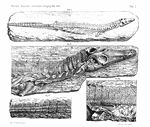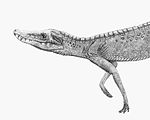| Sphenosuchia | |
|---|---|
 | |
| Life restoration of Hesperosuchus agilis | |
| Scientific classification | |
| Kingdom: | Animalia |
| Phylum: | Chordata |
| Class: | Reptilia |
| Superorder: | Crocodylomorpha |
| Informal group: | Sphenosuchia von Huene, 1942 |
| Genera | |
| Synonyms | |
| |
Sphenosuchia is a suborder of basal crocodylomorphs that first appeared in the Triassic and occurred into the Middle Jurassic. Most were small, gracile animals with an erect limb posture. They are now thought to be ancestral to crocodyliforms, a group which includes all living crocodilians.
Stratigraphic range
The earliest known members of the group (i.e. Hesperosuchus) are early Norian in age, found in the Blue Mesa Member of the Chinle Formation. Only one sphenosuchian is currently known from the Middle Jurassic, Junggarsuchus, from the Junggar Basin (Shishugou Formation) of China during either the Bathonian or the Callovian (~165 Ma) in age.,[1] and the Hallopodidae are known from the Late Jurassic of North America.[2]
Phylogeny
The monophyly of the group is debated, although several synapomorphies characterize the clade, including extremely slender limbs, a compact carpus and an elongate coracoid process.
In 2002, Clark and Sues found a possible sphenosuchian clade of Dibothrosuchus, Sphenosuchus, and possibly Hesperosuchus and Saltoposuchus, with several other genera in unresolved positions (Kayentasuchus, Litargosuchus, Pseudhesperosuchus, and Terrestrisuchus).[3] More recently, however, Clark et al. (2004) argued for the paraphyly of the group, contending that morphological characters were secondarily lost in more highly derived crocodylomorphs.[1] Further analysis and study is required before the group's monophyly is resolved with certainty — a perfect phylogenetic analysis is, at present, impossible due to a paucity of fossil remains demonstrating phylogenetically informative characters.
Below is a cladogram modified from Nesbitt (2011).[4] Sphenosuchians are marked by the green bracket.
| Sphenosuchians |
Genera
| Genus | Status | Age | Location | Unit | Notes | Images |
|---|---|---|---|---|---|---|
| Valid | Early Jurassic | Lower Lufeng Series |  | ||
| Valid | Late Triassic | Newark Supergroup | |||
| Valid | Late Triassic (Carnian) | Schilfsandstein Formation | A possible sphenosuchian;[5] alternatively, it could be an erpetosuchid.[6] |  | |
| Valid | Late Triassic (Carnian) | Chinle Formation | ||||
| Valid | Middle Jurassic | Shishugou Formation |  | ||
| Valid | Early Jurassic (Sinemurian - Pliensbachian) | Kayenta Formation | |||
| Valid | Early Jurassic | Elliot Formation |  | |||
| Nomen dubium | Late Triassic | Dockum Group | An indeterminate sphenosuchian known only from undiagnostic vertebrae[7] | ||
| Valid | Early Jurassic | Lower Lufeng Series | |||
| Valid | Late Triassic (Norian) | Los Colorados Formation | |||
| Valid | Late Triassic | Redonda Formation | |||
| Valid | Late Triassic (Norian) |
| Löwenstein Formation Trossingen Formation Lossiemouth Sandstone | |||
| Valid | Early Jurassic | Elliot Formation | ||||
| Valid. | Late Triassic |  | ||||
| Valid | Late Triassic | Ischigualasto Formation |
References
- ^ a b Clark, J.M., et al. (2004).A Middle Jurassic 'sphenosuchian' from China and the origin of the crocodylian skull Nature 430:1021-1024.
- ^ Leardi, Juan Martin; Pol, Diego; Clark, James Matthew (2017-01-19). "Detailed anatomy of the braincase of Macelognathus vagans Marsh, 1884 (Archosauria, Crocodylomorpha) using high resolution tomography and new insights on basal crocodylomorph phylogeny". PeerJ. 5: e2801. doi:10.7717/peerj.2801. ISSN 2167-8359.
- ^ Clark, James M.; Sues, Hans-Dieter (2002). "Two new basal crocodylomorph archosaurs from the Lower Jurassic and the monophyly of the Sphenosuchia". Zoological Journal of the Linnean Society. 136: 77–95. doi:10.1046/j.1096-3642.2002.00026.x.
- ^ Nesbitt, S.J. (2011). "The early evolution of archosaurs: relationships and the origin of major clades" (PDF). Bulletin of the American Museum of Natural History. 352: 1–292. doi:10.1206/352.1. hdl:2246/6112.
- ^ a b Lucas, S. G.; Wild, R.; Hunt, A. P. (1998). "Dyoplax O. Fraas, a Triassic sphenosuchian from Germany". Stuttgarter Beiträge zur Naturkunde, B. 263: 1–13.
- ^ Michael W. Maisch; Andreas T. Matzke; Thomas Rathgeber (2013). "Re-evaluation of the enigmatic archosaur Dyoplax arenaceus O. Fraas, 1867 from the Schilfsandstein (Stuttgart Formation, lower Carnian, Upper Triassic) of Stuttgart, Germany". Neues Jahrbuch für Geologie und Paläontologie - Abhandlungen. 267 (3): 353–362. doi:10.1127/0077-7749/2013/0317.
- ^ Clark, J. M.; Sues, H.-D.; Berman, D. S. (2001). "A new specimen of Hesperosuchus agilis from the Upper Triassic of New Mexico and the interrelationships of basal crocodylomorph archosaurs". Journal of Vertebrate Paleontology. 20 (4): 683–704. doi:10.1671/0272-4634(2000)020[0683:ANSOHA]2.0.CO;2.
- ^ Harris, Jerald D.; Lucas, Spencer G.; Estep, J. W.; Jianjun Li (2000). "A new and unusual sphenosuchian (Archosauria: Crocodylomorpha) from the Lower Jurassic Lufeng Formation, People's Republic of China". Neues Jahrbuch für Geologie und Paläontologie, Abhandlungen. 215 (1): 47–68. doi:10.1127/njgpa/215/2000/47.